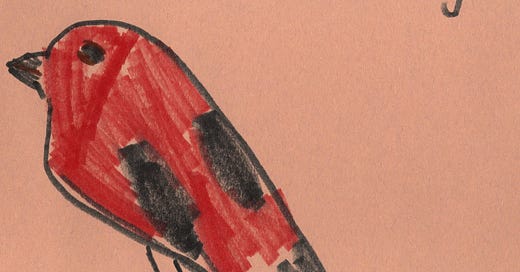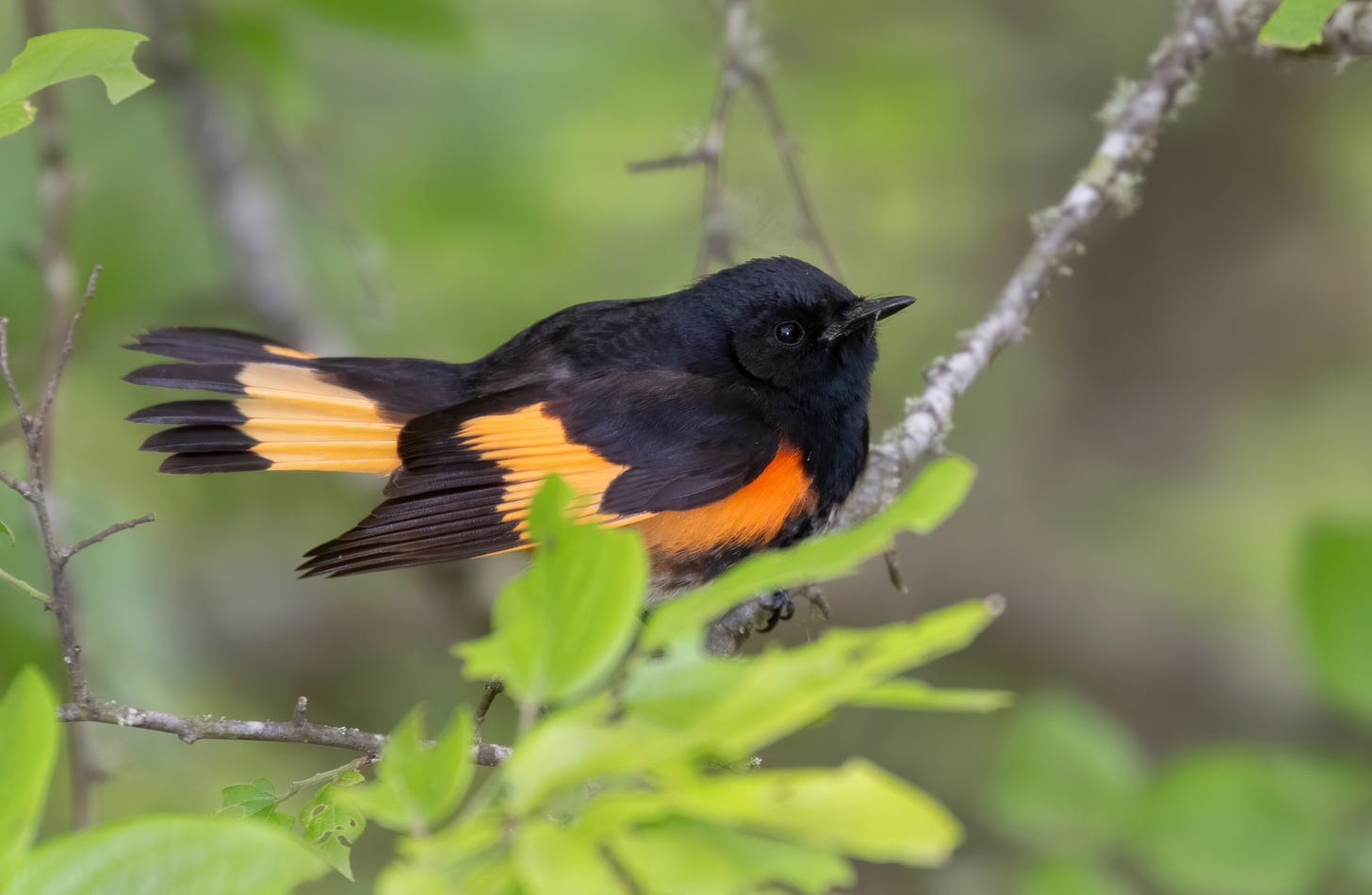Unlike the slavish quarters of labor time made up by corporate humanoids, micro-seasons are straight from source, the great unity, the god-babe herself: Mama Natura. Current Japanese micro-season (out of 72!): peonies bloom. As for McGolrick Park, New York City and perhaps even larger swathes of the eastern US, we notice—
MICRO-SEASONINGS
Grosbeaks & Tanagers return • First Spring Blast • Orchard Orioles • Redbuds show green • Chimney Swifts return • Dandelion seed heads
Did we miss anything? We’ll declare this micro-season’s “official” name at year’s end.
Our blast of warblers includes Common Yellowthroat, Prairie Warbler, Black-throated Blue Warbler, Nashville Warbler, Cape May Warbler, Northern Parula and Ovenbird; plus vireos Red-eyed and Yellow-throated (latter being an eBird first seen for McGolrick)
MAY 4, 2024 — SATURDAY
Conditions: Warmer than predicted • Attendance: 138 at peak 😳😄 • Vibrations: Wide open
Pic of the day via @robtruglia:
Saturday birds: Black-and-white Warbler · Black-throated Blue Warbler · Chipping Sparrow · Common Grackle · Downy Woodpecker · Gray Catbird · House Finch · White-throated Sparrow · Northern Flicker · Northern Parula · Ovenbird · Red-bellied Woodpecker · Rose-breasted Grosbeak (heard) · Yellow-bellied Sapsucker · Blue Jay · Laughing Gull (flyover) · … And the virtually always present in urban parks like McGolrick: Rock Pigeon, European Starling, American Robin, House Sparrow, Mourning Dove. Learn these last 5 and you’ll be set to notice less common birds.
Awards: We honored club OG Jeremy Danneman (a.k.a. Danny-man Danny) for logging 19 specimens in iNaturalist—the most of any clubber—during the City Nature Challenge. Brother gets a tee and a ticket to Nonhuman Teachers’ May 22 event HORT/CULTURE, where
Corey Fogel will perform John Cage's seminal 1976 piece Branches, which calls for the use of amplified seed pods, cacti, and other plant materials selected by the performer(s)
Jared Margulies will give a multimedia presentation on his 2023 book The Cactus Hunters, which explores the illegal trade in succulents, and the passion that drives it
If you haven’t downloaded iNaturalist, do it! It’ll seriously aid your quest to commune with surrounding flora and fauna. Photo ID instructions here. It’s how your correspondent got started learning birds’ names!
MICRO-LESSON: TANAGERS
Look up.
On Monday, April 29, Scarlet Tanagers returned to McGolrick Park. That word “tanager” should, starting now, connote beautifully colored medium-sized bird.
In the US we basically have three. (A few more if you’re counting Mexican tannies who pop into southwestern states from the Sierra Madres. We’ll save that bio-regional quirk, and its wonderful birds, for another lesson.) The three are:



Scarlet Tanager: Scarlets spend our winter in South America, cross the eastern US in spring, then summer in the northern US & Canada. Meaning these babes are right now findable in NYC parks, including McGolrick. Neon red with bold black wings. Females and young males swap neon red for olive-yellow, but retain the dark flappers.
Summer Tanager: True to name, these hotties summer in the bottom half of the US, pushing slightly more northward east of the Rockies. Not as common in New York City as Scarlets, but possible. Painterly red all over plus a chunky, light-colored bill. Summers can rock a molting, yellow or dark-feathered look that make them resemble the other two tanagers. Check the bill if you’re suspicious.
Western Tanager: A west of the Rockies speciality. Yellow dudes who went headfirst into kool-aid. Virtually impossible you’ll see one of these in NYC. Though a female vagrant—term means rare, probably blown off-course bird—visited Carl Schurz Park on the Upper East Side a few winters in a row. Jay Z. tells that sweet story!
Want more? Learn about the Hepatic and Flame-colored Tanagers
Learn about threats to Tanagers here
Ogle non-US tanager beauties here
ON NOTICE
American Redstart
American Redstarts are coming. They’re warblers, so … they’re small. But before you new birders roll your increasingly-proficient-yet-small-bird-fatigued eyes into the backs of your heads, note: American Redstarts A) are among the biggest of NYC’s most common 22 B) have a telltale wings out, long fantail hunting move that makes them easy to notice C) are—in breeding plumage—freaking black and neon orange.
Another reason to like ‘em: American Redstarts can be found in New York City all summer. That’s less true in McGolrick Park, where there’s probably too little territory and resource to make a summer home. But keep your animal senses turned up at bigger parks for their flitting bodies and short, sharp calls.
Female and young male American Redstarts swap that black and orange plumage for gray and yellow. See here
Redstarts are named for the Common Redstart, a Eurasian bird. Start means tail in Old English
The super hot Painted Redstart is known to summer in limited parts of the southwest US—the quirky zone mentioned in the tanager section
You can see frequency charts for all of McGolrick Park’s 111 eBirded species here
UPDATES, ANNOUNCEMENTS, REQS
AHOY-HOY
For the run of May, in addition to our usual Saturday, 9am walks, we’ll host McGolrick Bird Club sessions Monday, Tuesday and Wednesday mornings. These ~hourlong sessions will start at 6:30am. Hello, sun in my face, you’ll find yourself Mary Oliver-ing. The whiteboard’ll be out and updated some days. So if you can’t make it, have a look-see
Another near-flung Sunday Walk coming up:
5/19 - Brooklyn Bridge Park — meet here, 9am







